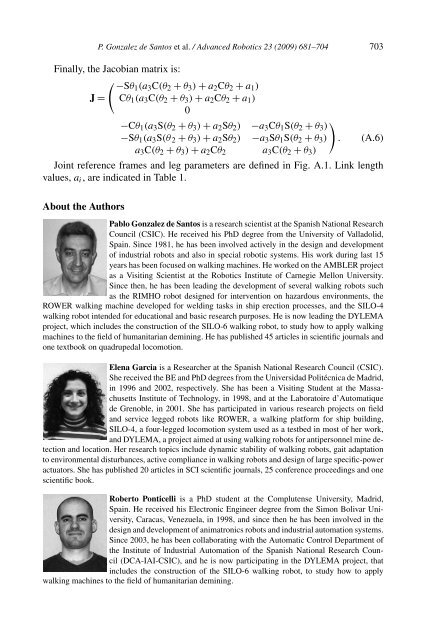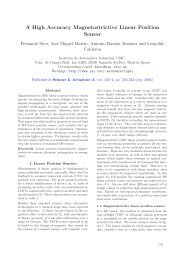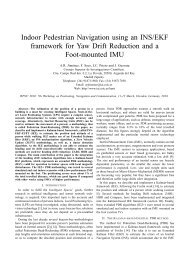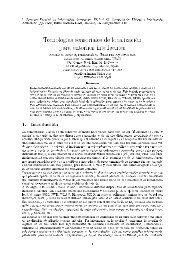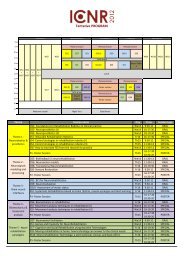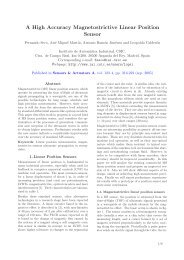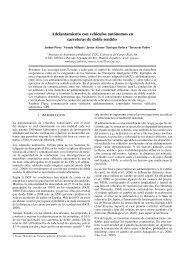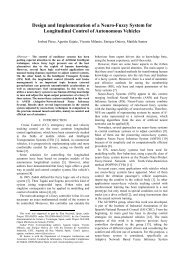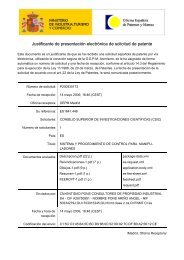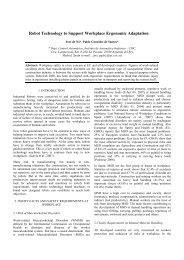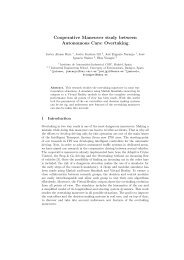Full paper Minimizing Energy Consumption in Hexapod Robots
Full paper Minimizing Energy Consumption in Hexapod Robots
Full paper Minimizing Energy Consumption in Hexapod Robots
You also want an ePaper? Increase the reach of your titles
YUMPU automatically turns print PDFs into web optimized ePapers that Google loves.
P. Gonzalez de Santos et al. / Advanced Robotics 23 (2009) 681–704 703F<strong>in</strong>ally, the Jacobian matrix is:( −Sθ1 (a 3 C(θ 2 + θ 3 ) + a 2 Cθ 2 + a 1 )J = Cθ 1 (a 3 C(θ 2 + θ 3 ) + a 2 Cθ 2 + a 1 )0−Cθ 1 (a 3 S(θ 2 + θ 3 ) + a 2 Sθ 2 ))−a 3 Cθ 1 S(θ 2 + θ 3 )−Sθ 1 (a 3 S(θ 2 + θ 3 ) + a 2 Sθ 2 ) −a 3 Sθ 1 S(θ 2 + θ 3 ) . (A.6)a 3 C(θ 2 + θ 3 ) + a 2 Cθ 2 a 3 C(θ 2 + θ 3 )Jo<strong>in</strong>t reference frames and leg parameters are def<strong>in</strong>ed <strong>in</strong> Fig. A.1. L<strong>in</strong>k lengthvalues, a i , are <strong>in</strong>dicated <strong>in</strong> Table 1.About the AuthorsPabloGonzalezdeSantosis a research scientist at the Spanish National ResearchCouncil (CSIC). He received his PhD degree from the University of Valladolid,Spa<strong>in</strong>. S<strong>in</strong>ce 1981, he has been <strong>in</strong>volved actively <strong>in</strong> the design and developmentof <strong>in</strong>dustrial robots and also <strong>in</strong> special robotic systems. His work dur<strong>in</strong>g last 15years has been focused on walk<strong>in</strong>g mach<strong>in</strong>es. He worked on the AMBLER projectas a Visit<strong>in</strong>g Scientist at the Robotics Institute of Carnegie Mellon University.S<strong>in</strong>ce then, he has been lead<strong>in</strong>g the development of several walk<strong>in</strong>g robots suchas the RIMHO robot designed for <strong>in</strong>tervention on hazardous environments, theROWER walk<strong>in</strong>g mach<strong>in</strong>e developed for weld<strong>in</strong>g tasks <strong>in</strong> ship erection processes, and the SILO-4walk<strong>in</strong>g robot <strong>in</strong>tended for educational and basic research purposes. He is now lead<strong>in</strong>g the DYLEMAproject, which <strong>in</strong>cludes the construction of the SILO-6 walk<strong>in</strong>g robot, to study how to apply walk<strong>in</strong>gmach<strong>in</strong>es to the field of humanitarian dem<strong>in</strong><strong>in</strong>g. He has published 45 articles <strong>in</strong> scientific journals andone textbook on quadrupedal locomotion.Elena Garcia is a Researcher at the Spanish National Research Council (CSIC).She received the BE and PhD degrees from the Universidad Politécnica de Madrid,<strong>in</strong> 1996 and 2002, respectively. She has been a Visit<strong>in</strong>g Student at the MassachusettsInstitute of Technology, <strong>in</strong> 1998, and at the Laboratoire d’Automatiquede Grenoble, <strong>in</strong> 2001. She has participated <strong>in</strong> various research projects on fieldand service legged robots like ROWER, a walk<strong>in</strong>g platform for ship build<strong>in</strong>g,SILO-4, a four-legged locomotion system used as a testbed <strong>in</strong> most of her work,and DYLEMA, a project aimed at us<strong>in</strong>g walk<strong>in</strong>g robots for antipersonnel m<strong>in</strong>e detectionand location. Her research topics <strong>in</strong>clude dynamic stability of walk<strong>in</strong>g robots, gait adaptationto environmental disturbances, active compliance <strong>in</strong> walk<strong>in</strong>g robots and design of large specific-poweractuators. She has published 20 articles <strong>in</strong> SCI scientific journals, 25 conference proceed<strong>in</strong>gs and onescientific book.Roberto Ponticelli is a PhD student at the Complutense University, Madrid,Spa<strong>in</strong>. He received his Electronic Eng<strong>in</strong>eer degree from the Simon Bolivar University,Caracas, Venezuela, <strong>in</strong> 1998, and s<strong>in</strong>ce then he has been <strong>in</strong>volved <strong>in</strong> thedesign and development of animatronics robots and <strong>in</strong>dustrial automation systems.S<strong>in</strong>ce 2003, he has been collaborat<strong>in</strong>g with the Automatic Control Department ofthe Institute of Industrial Automation of the Spanish National Research Council(DCA-IAI-CSIC), and he is now participat<strong>in</strong>g <strong>in</strong> the DYLEMA project, that<strong>in</strong>cludes the construction of the SILO-6 walk<strong>in</strong>g robot, to study how to applywalk<strong>in</strong>g mach<strong>in</strong>es to the field of humanitarian dem<strong>in</strong><strong>in</strong>g.


